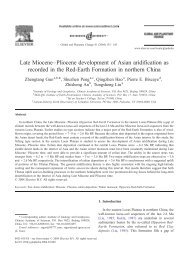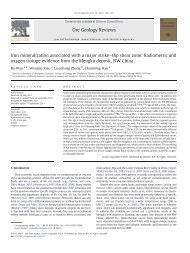constraints from fluid inclusions and Sr, C a
constraints from fluid inclusions and Sr, C a
constraints from fluid inclusions and Sr, C a
Create successful ePaper yourself
Turn your PDF publications into a flip-book with our unique Google optimized e-Paper software.
2 K. LI et al.<br />
Fig. 1. Map showing the geology, tectonics <strong>and</strong> locations of sampled wells.<br />
uplifted <strong>and</strong> exposed to the surface. However, this mechanism<br />
alone cannot account for high porosity in the reservoirs<br />
away <strong>from</strong> the unconformities, where meteoric water<br />
supply would have been limited, or in the deep reservoirs<br />
(e.g. >6000 m), where most pore space is typically completely<br />
destroyed because of compaction <strong>and</strong> cementation<br />
(Halley & Schmoker 1983).<br />
Carbonate dissolution by hydrothermal water has been<br />
invoked to explain ‘‘sag’’ occurrences above porous hydrothermal<br />
dolomite in deep carbonates in some petroleumproducing<br />
basins (Davies & Smith 2006). In the Central<br />
Tarim Basin, fracture-filling barite, fluorite, <strong>and</strong> pyrite<br />
probably originated <strong>from</strong> hydrothermal activity (Cai et al.<br />
2008). However, it is not clear whether there has been<br />
hydrothermal activity in the Tahe oilfield, because the<br />
chemical <strong>and</strong> isotopic composition of <strong>Sr</strong>, C, <strong>and</strong> O <strong>and</strong><br />
thus the source of hydrothermal water have not previously<br />
been characterized. The specific question being addressed<br />
in this study is the origin <strong>and</strong> evolution of palaeo-waters in<br />
the carbonates in the northern Tarim Basin.<br />
To address this issue, this paper presents <strong>fluid</strong>-inclusion<br />
data, trace element compositions, <strong>and</strong> strontium, carbon,<br />
<strong>and</strong> oxygen isotopes <strong>from</strong> the fracture-filling, karst-filling<br />
<strong>and</strong> interparticle calcite cements <strong>and</strong> formation water in<br />
the Ordovician in Tahe area. Fluid-inclusion data can be<br />
used to indicate temperatures <strong>and</strong> salinities during mineralization,<br />
<strong>and</strong> <strong>Sr</strong>, C, <strong>and</strong> O isotopic compositions have<br />
widely been used to indicate the origin of waters, mixing<br />
of different water bodies, <strong>and</strong> cross-formation water flow<br />
(Worden & Matray 1995; Cai et al. 2001a,b, 2008; Schwinn<br />
et al. 2006; Worden et al. 2006; S<strong>and</strong>strom & Tullborg<br />
2009). Analysis of these types of data is expected to<br />
supply reliable information to address the source <strong>and</strong> evolution<br />
of the water in this field.<br />
GEOLOGICAL SETTING<br />
The Tarim basin, which is located in northwest of China<br />
(Fig. 1), has a long history of successful petroleum exploration.<br />
Recently, giant petroleum resources have been found<br />
in reef-shoal facies limestone in the Ordovician in the Central<br />
Tarim <strong>and</strong> Tabei uplifts (Fig. 1). Detailed descriptions<br />
of the geological settings of the Tarim Basin have been<br />
published previously (Cai et al. 2001a,b, 2008). In brief,<br />
Upper Proterozic (Sinian) beach to shallow marine facies<br />
siliciclastic rock <strong>and</strong> carbonates lie on Archean <strong>and</strong> Proterozoic<br />
crystalline basement. The overlying Cambrian <strong>and</strong><br />
Ordovician strata are composed of platform facies limestone<br />
<strong>and</strong> dolomite, slope facies limestone <strong>and</strong> marlstone,<br />
<strong>and</strong> basinal facies mudstone, shale <strong>and</strong> marlstone. The Silurian<br />
to Carboniferous sequence consists of marine s<strong>and</strong>stone<br />
<strong>and</strong> mudstone. Permian strata are composed of<br />
lacustrine sediment <strong>and</strong> volcanic rock. Following the emergence<br />
of the sediments, Mesozoic <strong>and</strong> Cenozoic units are<br />
represented by nonmarine fluvial s<strong>and</strong>stone <strong>and</strong> mudstone.<br />
Various orogenic events have led to nine recognized<br />
unconformities in the basin (Table 1).In the Tabei area,<br />
thrusting <strong>and</strong> uplift in the north of the Tahe area was significantly<br />
greater than in the south as a result of different<br />
structural stresses during the late Caledonian Orogeny at<br />
Ó 2010 Blackwell Publishing Ltd




